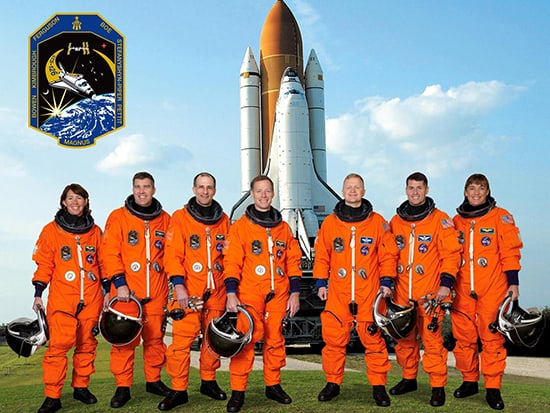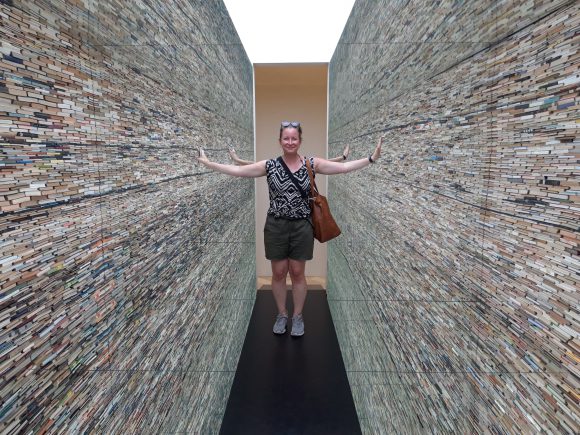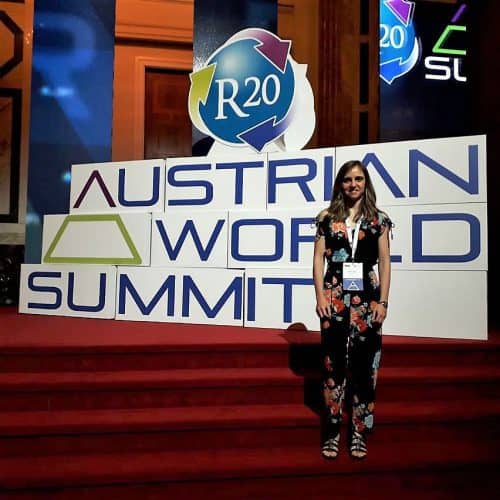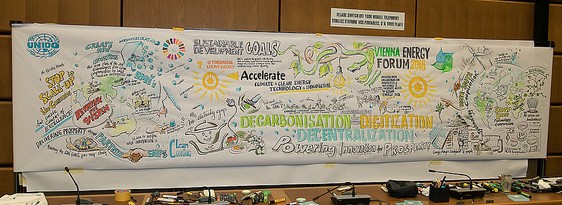Sep 23, 2019 | Ecosystems, Environment, Sustainable Development
By Frank Sperling, Senior Project Manager (FABLE) in the IIASA Ecosystems Services and Management Program
Food and land use systems play a critical role in managing climate risks and bringing the world onto a sustainable development trajectory.
The UN Secretary General’s Climate Action Summit in New York on 23 September seeks to catalyze further momentum for climate change mitigation and adaptation. The transformation of the food and land use system will play a critical role in managing climate risks and bringing the world onto a sustainable development trajectory.
Today’s food and land use systems are confronted with a great variety of challenges. This includes delivering on universal food security and better diets by 2030. Over the last decades, great strides have been made towards achieving universal food security, but this progress recently grinded to a halt. The number of people suffering from chronic hunger has been rising again from below 800 million in 2015 to over 820 million people today [1]. Food security is however not only about a sufficient supply of calories per person. It is also about improving diets, addressing the worldwide increase in the prevalence of obesity, and how we use and value environmental goods and services.

© Paulus Rusyanto | Dreamstime.com
Agriculture, forestry and other land use currently account for around 24% of greenhouse gas emissions caused by human activities [2]. Land use changes are also a major driver behind the worldwide loss of biodiversity [3]. Clearly, in light of population growth and the increasingly visible fingerprints of a human-induced global climate crisis and other environmental changes, business as usual is not an option.
Systems thinking is key in shifting towards more sustainable practices. A new report released by the Food and Land-Use System (FOLU) Coalition showcases that there is much to be gained. There are massive hidden costs in our current food and land use systems. The report outlines ten critical transitions, which can substantially reduce these hidden costs, thereby generating an economic prize, while improving human and planetary health.
The International Institute for Applied Systems Analysis (IIASA) contributed to the analytics underpinning the report [4], applying the Global Biosphere Management Model (GLOBIOM) [5]. A “better futures” scenario, which seeks to collectively address development and environmental objectives, was compared to a “current trends” scenario, which is basically a continuation of a business-as-usual scenario. The assessment illustrates that an integrated approach that acknowledges the interactions in the food and land use space, can help identify synergies and manage trade-offs across sectors. For example, shifting towards healthy diets not only improves human health, but also reduces pressure on land, thereby helping to improve the solution space for addressing climate change and halting biodiversity loss.
While understanding that the global picture is important, practical solutions require engagement with national and subnational governments. The challenge is to identify development pathways that address the development needs and aspirations of countries within global sustainability contexts. As part of FOLU, the Food, Agriculture, Biodiversity, Land and Energy (FABLE) Consortium was initiated to do exactly this. The FABLE Secretariat, jointly hosted by the Sustainable Development Solutions Network (SDSN) and IIASA, is working with knowledge institutions from developed and developing countries, to explore the interactions between national and global level objectives and their implications for pathways towards sustainable food and land use systems. Preliminary results from inter-active scenario and development planning exercises, so-called Scenathons, were recently presented in the FABLE 2019 report.
These initiatives highlight that acknowledging and embracing complexity can help reconcile development and environmental interests. This also entails rethinking how we relate to and manage nature’s services and their role in providing the foundation for the welfare of current and future generations. This is underscored by the prominent role nature-based solutions are given at the UN Secretary General’s Climate Action Summit. We need to move from silo-based, sector specific, single objective approaches to a focus on multiple objective solutions. In the land use space, this means embedding agriculture in the broader land use context, which accounts for and values environmental services, and linking to the food system where dietary choices shape human health and the demand for land.
Doing so will help bridge the international policy objectives of the UN Framework Convention on Climate Change (UNFCCC), the UN Convention on Combating Desertification (UNCCD), the Convention on Biological Diversity (CBD), and the Sustainable Development Goals (SDGs) enshrined in ‘The 2030 Agenda for Sustainable Development’. This represents an opportunity to create a new value proposition for agriculture and other land use activities where environmental stewardship is rewarded.
References
[1] Food and Agriculture Organization (FAO) et al. (2019). The State of Food Security and Nutrition in the World 2019. Safeguarding against economic slowdowns and downturns. Rome, FAO.
[2] Intergovernmental Panel on Climate Change (IPCC) (2019). Climate Change and Land. IPCC Special Report on climate change, desertification, land degradation, sustainable land management, food security, and greenhouse gas fluxes in terrestrial ecosystems. Intergovernmental Panel on Climate Change (IPCC).
[3] Intergovernmental Science-Policy Platform on Biodiversity and Ecosystem Services (IPBES) (2018). The IPBES assessment report on land degradation and restoration. Montanarella, L., Scholes, R., and Brainich, A. (eds.). Secretariat of the Intergovernmental Science-Policy Platform on Biodiversity and Ecosystem Services, Bonn, Germany. 744 pages.
[4] Deppermann, A. et al. 2019. Towards sustainable food and land-use systems: Insights from integrated scenarios of the Global Biosphere Management Model (GLOBIOM). Supplemental Paper to The 2019 Global Consultation Report of the Food and Land Use Coalition Growing Better: Ten Critical Transitions to Transform Food and Land Use. Laxenburg, IIASA.
[5] Havlik P, Valin H, Herrero M, Obersteiner M, Schmid E, Rufino MC, Mosnier A, Thornton PK, et al. (2014). Climate change mitigation through livestock system transitions. Proceedings of the National Academy of Sciences 111 (10): 3709-3714. DOI: 1073/pnas.1308044111 [pure.iiasa.ac.at/10970].
Note: This article gives the views of the author, and not the position of the Nexus blog, nor of the International Institute for Applied Systems Analysis.
Jul 11, 2019 | IIASA Network, USA, Women in Science
Rachel Potter, IIASA communications officer, interviews retired NASA Astronaut and Principal of AstroPlanetview LLC, Sandra H Magnus on insights about our world she has gained from her time living on the International Space Station.

©NASA Photo / Houston Chronicle, Smiley N. Pool
Q: Can you tell us a bit about your specific areas of research as a scientist?
A: My PhD was on a new material system being investigated for thermionic cathodes, which are used as electron sources for satellite communication systems. My research was an effort to look at the system methodically and from a science viewpoint to understand physically what was going on in order to inform the design of more robust devices. If you can operate the cathode at a lower temperature, that means a longer life for it, which is a good thing for satellites! Post-PhD I was however admitted to the Astronaut Office and that, quite frankly, pretty much put an end to my career as a researcher, or at least as a principal investigator (PI). The work I did on the International Space Station was at the direction of other PIs who had proposed, and been granted, experiments in space.
Q: Your career has spanned a wide range of settings from the NASA Astronaut Corps to your current role as Principal of AstroPlanetview LLC – what is the common thread or focus that has run through your work?
A: Following my curiosity and looking for challenges. I always want to be challenged and feel that I am learning new things. If I feel that I have become stagnant, I start looking for how to change that situation.
Q: What have been the personal highlights of your career?
A: Clearly flying in space! I feel very fortunate, however, to have been in the Astronaut Office during the era of the space station. I enjoyed very much working in a collaborative, multicultural, international environment where we had a big team of people from around the world working on something that benefits the planet.
Q: What are the greatest lessons you have learned from seeing the Earth from space?
A: I was so excited to FINALLY be going into space after hoping to do just that for over 20 years. The Earth is our spaceship – a closed system in which everything on the planet affects, and is connected to everything else on the planet. An action somewhere means a reaction somewhere else, even if it is not always first order (and usually it is not). Also, the planet looks incredibly beautiful and very fragile – we have to take care of it!

© NASA STS-126 Shuttle Mission full crew photo (5 March 2008), Sandra H Magnus far left.
Q: What do you see as key to solving the complex problems the Earth faces in terms of sustainability?
A: Having the will to do it as a community. If you have the will, commitment and a clear, agreed-to, articulation of the common goal, we can pretty much accomplish anything we want to.
Q: How do you see IIASA being able to build bridges between countries across political divides?
A: Well, when we want to solve problems, it really is all about relationships at the end of the day. It is easy to demonize or keep your distance from abstract ideas or the ubiquitous “They” but when you meet people, understand them as individuals and the context of their backgrounds that lead them to have different views and approaches to life and solving problems, it is much easier to visualize how you can work together to tackle issues. The relationships are the bridges.
Q: What advice would you give to young women researchers wanting to make it into Aeronautics?
A: To young women (and young men, too, really) I would say, “If you have a dream to go do something, then you owe it to yourself to go for it and try it!” Never let anyone else define who you are or tell you what you can or cannot do – believe in yourself and give it a try. Maybe you will make it, maybe you will not, but it will be on your own terms, with you pushing yourself and regardless of the outcome you will have a deeper understanding of yourself, and that is always a good thing.
Sandra H Magnus visited IIASA on 21 June 2019 in cooperation with the US Embassy Vienna, to give a lecture entitled “Perspectives from Space” to IIASA staff and this year’s participants of the IIASA Young Scientists Summer Program. IIASA has a worldwide network of collaborators who contribute to research by collecting, processing, and evaluating local and regional data that are integrated into IIASA models. The institute has 819 research partner institutions in member countries and works with research funders, academic institutions, policymakers, and individual researchers in national member organizations.
Notes:
This article gives the views of the authors, and not the position of the Nexus blog, nor of the International Institute for Applied Systems Analysis.
May 29, 2019 | Science and Policy, Vietnam
Tran Thi Vo-Quyen, IIASA guest research scholar from the Vietnam Academy of Science and Technology (VAST), talks to Professor Dr. Ninh Khac Ban, Director General of the International Cooperation Department at VAST and IIASA council member for Vietnam, about achievements and challenges that Vietnam has faced in the last 5 years, and how IIASA research will help Vietnam and VAST in the future.

Professor Dr. Ninh Khac Ban, Director General of the International Cooperation Department at VAST and IIASA council member for Vietnam
What have been the highlights of Vietnam-IIASA membership until now?
In 2017, IIASA and VAST researchers started working on a joint project to support air pollution management in the Hanoi region which ultimately led to the successful development of the IIASA Greenhouse Gas – Air Pollution Interactions and Synergies (GAINS) model for the Hanoi region. The success of the project will contribute to a system for forecasting the changing trend of air pollution and will help local policy makers develop cost effective policy and management plans for improving air quality, in particular, in Hanoi and more widely in Vietnam.
IIASA capacity building programs have also been successful for Vietnam, with a participant of the 2017 Young Scientists Summer Program (YSSP) becoming a key coordinator of the GAINS project. VAST has also benefited from two members of its International Cooperation Department visiting the IIASA External Relations Department for a period of 3 months in 2018 and 2019, to learn about how IIASA deals with its National Member Organizations (NMOs) and to assist IIASA in developing its activities with Vietnam.
What do you think will be the key scientific challenges to face Vietnam in the next few years? And how do you envision IIASA helping Vietnam to tackle these?
In the global context Vietnam is facing many challenges relating to climate change, energy issues and environmental pollution, which will continue in the coming years. IIASA can help key members of Vietnam’s scientific community to build specific scenarios, access in-depth knowledge and obtain global data that will help them advise Vietnamese government officials on how best they can overcome the negative impact of these issues.
As Director General of the International Cooperation Department, can you explain your role in VAST and as representative to IIASA in a little more detail?
In leading the International Cooperation Department at VAST, I coordinate all collaborative science and technology activities between VAST and more than 50 international partner institutions that collaborate with VAST.
As the IIASA council representative for Vietnam, I participate in the biannual meeting for the IIASA council, I was also a member of the recent task force developed to implement the recommendations of a recent independent review of the institute. I was involved in consulting on the future strategies, organizational structure, NMO value proposition and need to improve the management system of IIASA.
In Vietnam, I advised on the establishment of a Vietnam network for joining IIASA and I implement IIASA-Vietnam activities, coordinating with other IIASA NMOs to ensure Vietnam is well represented in their countries.
You mentioned the development of the Vietnam-IIASA GAINS Model. Can you explain why this was so important to Vietnam and how it is helping to improve air quality and shape Vietnamese policy around air pollution?
Air pollution levels in Vietnam in the last years has had an adverse effect on public health and has caused significant environmental degradation, including greenhouse gas (GHG) emissions, undermining the potential for sustainable socioeconomic development of the country and impacting the poor. It was important for Vietnam to use IIASA researchers’ expertise and models to help them improve the current situation, and to help Vietnam in developing the scientific infrastructure for a long-lasting science-policy interface for air quality management.
The project is helping Vietnamese researchers in a number of ways, including helping us to develop a multi-disciplinary research community in Vietnam on integrated air quality management, and in providing local decision makers with the capacity to develop cost-effective management plans for the Hanoi metropolitan area and surrounding regions and, in the longer-term, the whole of Vietnam.
About VAST and Ninh Khac Ban
VAST was established in 1975 by the Vietnamese government to carry out basic research in natural sciences and to provide objective grounds for science and technology management, for shaping policies, strategies and plans for socio-economic development in Vietnam. Ninh Khac Ban obtained his PhD in Biology from VAST’s Institute of Ecology and Biological Resources in 2001. He has managed several large research projects as a principal advisor, including several multinational joint research projects. His successful academic career has led to the publication of more than 34 international articles with a high ranking, and more than 60 national articles, and 2 registered patents. He has supervised 5 master’s and 9 PhD level students successfully to graduation and has contributed to pedagogical texts for postgraduate training in his field of expertise.
Notes:
More information on IIASA and Vietnam collaborations. This article gives the views of the authors, and not the position of the Nexus blog, nor of the International Institute for Applied Systems Analysis.
Oct 16, 2018 | Alumni, Climate Change, Environment, Science and Policy, Women in Science, Young Scientists

Laura Mononen experiencing a creative ”world flow” in the art installation ‘Passage’ by Matej Kren in Bratislava | © Kati Niiles
By Sandra Ortellado, IIASA 2018 Science Communication Fellow
If fashion is the science of appearances, what can beauty and aesthetics tell us about the way we perceive the world, and how it influences us in turn?
From cognitive science research, we know that aesthetics not only influence superficial appearances, but also the deeper ways we think and experience. So, too, do all kinds of creative thinking create change in the same way: as our perceptions of the world around us changes, the world we create changes with them.
From the merchandizing shelves of H&M and Vero Moda to doctoral research at the Faculty of Information Technology at the University of Jyväskylä, Finland, 2018 YSSP participant Laura Mononen has seen product delivery from all angles. Whether dealing with commercialized goods or intellectual knowledge, Mononen knows that creativity is all about a change in thinking, and changing thinking is all about product delivery.
“During my career in the fashion and clothing industry, I saw the different levels of production when we sent designs to factories, received clothing back, and then persuaded customers to buy them. It was all happening very effectively,” says Mononen.
But Mononen saw potential for product delivery beyond selling people things they don’t need. She wanted to transfer the efficiency of the fashion world in creating changes in thinking to the efforts to build a sustainable world.
“Entrepreneurs make change with products and companies, fashion change trends and sell them. I’m really interested in applying this kind of change to science policy and communication,” says Mononen. “We treat these fields as though they are completely different, but the thing that is common is humans and their thinking and behaving.”
Often, change must happen in our thinking first before we can act. That’s why Mononen is getting her doctorate in cognitive science. Her YSSP project involved heavy analysis of systems theories of creativity to find patterns in the way we think about creativity, which has been constantly changing over time.
In the past, creativity was seen as an ability that was characteristic of only certain very gifted individuals. The research focused on traits and psychological factors. Today, the thinking on creativity has shifted towards a more holistic view, incorporating interactions and relationships between larger systems. Instead of being viewed as a lightning bolt of inspiration, creativity is now seen as more of a gradual process.
New understandings of creativity also call on us to embrace paradoxes and chaos, see ourselves as part of nature rather than separate from it, experience the world through aesthetics, pay careful attention to our perception and how we communicate it, and transmit culture to the next generation.
Perhaps most importantly, Mononen found in her research that the understanding of creativity has changed to be seen as part of a process of self-creation as well as co-creation.
“The way we see creativity also influences ourselves. For example if I ask someone if they are creative, it’s the way they see themselves that influences how creative they are,” says Mononen. “I have found that it’s more crucial to us than I thought, creativity is everywhere and it’s everyday and we are sharing our creativity with others who are using that to do something themselves and so on.”
This means on the one hand that we use our creativity to decide who we are and how we see the world around us for ourselves. But it also means that the outcomes and benefits of creativity are now intended for society as a whole rather than purely for individuals, as it was in the past. It may sound like another paradox, but being able to embrace ambiguity and complexity and take charge of our role in a larger system is important for creating a sustainable future.
“From the IIASA perspective this finding brings hope because the more people see themselves as part of systems of creating things, the more we can encourage sustainable thinking, since nature is a part of the resources we use to create,” says Mononen.
Mononen says a systems understanding of creativity is especially important for people in leadership positions. If a large institution needs new and innovative solutions and technology, but doesn’t have the thinking that values and promotes creativity, then the cooperative, open-minded process of building is stifled.
Working in both the fashion industry and academic research, Mononen has encountered narrow-minded attitudes towards art and science firsthand.
“Communicating your research is very difficult coming from my background, because you don’t know how the other person is interpreting what you say,” says Mononen. “People have different ideas of what fashion and aesthetics are, how important they are and what they do. Additionally, scientific concepts are used differently in different fields.”
“We are often thinking that once we get information out there, then people will understand, but there are much more complex things going on to make change and create influence in settings that combine several different fields.” says Mononen.
For Mononen, the biggest lesson is that creativity can enhance the efforts of science towards a sustainable world simply by encouraging us to be aware of our own thinking, how it differs from that of others, and how it affects all of us.
“When you become more aware of your ways of thinking, you become more effective at communicating,” says Mononen. “It’s not always that way and it’s very challenging, but that’s what the research on creativity from a systems perspective is saying.”
May 28, 2018 | Air Pollution, Climate, Climate Change, Ecosystems, Energy & Climate, Women in Science
By Beatriz Mayor, Research Scholar at IIASA
On 14 and 15 May, Vienna hosted two important events within the frame of the world energy and climate change agendas: the Vienna Energy Forum and the R20 Austrian World Summit. Since I had the pleasure and privilege to attend both, I would like to share some insights and relevant messages I took home with me.

Beatriz Mayor at the Austrian World Summit © Beatriz Mayor
To begin with, ‘renewable energy’ was the buzzword of the moment. Renewable energy is not only the future, it is the present. Recently, 20-year solar PV contracts were signed for US$0.02/kWh. However, renewable energy is not only about mitigating the effects of climate change, but also about turning the planet into a world we (humans from all regions, regardless of the local conditions) want to live in. It is not only about producing energy, about reaching a number of KWh equivalent to the expected demand–renewables are about providing a service to communities, meeting their needs, and improving their ways of life. It does not consist only of taking a solar LED lamp to a remote rural house in India or Africa. It is about first understanding the problem and then seeking the right solution. Such a light will be of no use if a mother has to spend the whole day walking 10 km to find water at the closest spring or well, and come back by sunset to work on her loom, only to find that the lamp has run out of battery. Why? Because her son had to take it to school to light his way back home.
This is where the concept of ‘nexus’ entered the room, and I have to say that more than once it was brought up by IIASA Deputy Director General Nebojsa Nakicenovic. A nexus approach means adopting an integrated approach and understanding both the problems and the solutions, the cross and rebound effects, and the synergies; and it is on the latter that we should focus our efforts to maximize the effect with minimal effort. Looking at the nexus involves addressing the interdependencies between the water, energy, and food sectors, but also expanding the reach to other critical dimensions such as health, poverty, education, and gender. Overall, this means pursuing the Sustainable Development Goals (SDGs).

Vienna Energy Forum banner created by artists on the day © UNIDO / Flickr
Another key word that was repeatedly mentioned was finance. The question was how to raise and mobilize funds for the implementation of the required solutions and initiatives. The answer: blended funding and private funding mobilization. This means combining different funding sources, including crowd funding and citizen-social funding initiatives, and engaging the private sector by reducing the risk for investors. A wonderful example was presented by the city of Vienna, where a solar power plant was completely funded (and thus owned) by Viennese citizens through the purchase of shares.
This connects with the last message: the importance of a bottom-up approach and the critical role of those at the local level. Speakers and panelists gave several examples of successful initiatives in Mali, India, Vienna, and California. Most of the debates focused on how to search for solutions and facilitate access to funding and implementation in the Global South. However, two things became clear. Firstly, massive political and investment efforts are required in emerging countries to set up the infrastructural and social environment (including capacity building) to achieve the SDGs. Secondly, the effort and cost of dismantling a well-rooted technological and infrastructural system once put in place, such as fossil fuel-based power networks in the case of developed countries, are also huge. Hence, the importance of emerging economies going directly for sustainable solutions, which will pay off in the future in all possible aspects. HRH Princess Abze Djigma from Burkina Faso emphasized that this is already happening in Africa. Progress is being made at a critical rate, triggered by local initiatives that will displace the age of huge, donor-funded, top-down projects, to give way to bottom-up, collaborative co-funding and co-development.
Overall, if I had to pick just one message among the information overload I faced over these two days, it would be the statement by a young fellow in the audience from African Champions: “Africa is not underdeveloped, it is waiting and watching not to repeat the mistakes made by the rest of the world.” We should keep this message in mind.








You must be logged in to post a comment.